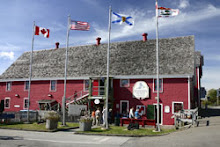 Hello Everyone,
Hello Everyone,One of the most fascinating exhibits at the Fisheries Museum of the Atlantic, in Lunenburg Nova Scotia, is a Parks Canada installation called The Bank Fishery ~ Age of Sail. The exhibit covers a 400-year period of fishing on the banks of the North Atlantic.
Detailed models of the vessels provide the highlight of the experience, covering the time of green fishing (1500s - 1700s) through to the schooners of the 1930s.
Green fishing means that the fish that were caught and salted were still wet when the vessels returned to their ports. The fleets from France were outfitted with large amounts of salt, which were readily available to them because of their unending supply of solar salt, at home. The fleets from Britain did not have the same amount of the resource and had to go ashore, usually at Newfoundland, to partially dry their catch in the sun.
The method of fishing, in these early years, is almost unimaginable by today’s standards.
The vessels were square-rigged, which required a large enough crew to climb the rigging and set the sails. This same crew did the fishing, from the deck of the vessels, while standing in tall barrels. The barrels were used for stability and to provide some semblance of warmth. The men would lower their fishing lines, which were usually at least 300 feet long, and would work for 10 or 12 hours, hauling the then-huge cod to the deck, all by hand.
The vessels were square-rigged, which required a large enough crew to climb the rigging and set the sails. This same crew did the fishing, from the deck of the vessels, while standing in tall barrels. The barrels were used for stability and to provide some semblance of warmth. The men would lower their fishing lines, which were usually at least 300 feet long, and would work for 10 or 12 hours, hauling the then-huge cod to the deck, all by hand.
The men were paid according to the number of fish that they caught. In order for the captain to keep an accurate tally, the tongues of the fish were cut out and driven on a short iron pole, one for each fisherman.
Research based on logbooks and legal depositions from the time period show that the amount of fish caught varied greatly. One voyage, in 1754, on the Saint-André, of Honfleur, France, showed that in some weeks the average catch per man was 10 fish per day. At other times, the men averaged 100 or more on a daily basis! Considering that some of the cod would have weighed several hundred pounds, the effort of hauling the deadweight of the fish aboard the vessel, from at least 300 feet, would have been backbreaking, dangerous work.
A common practice was that whoever caught the lowest number of fish, each day, had to clean up the deck and working areas, while the other men were able to go to their meals and bunks.
The men came to know coastal areas of what is now Canada with great intimacy. Some of the men from Britain eventually settled in ports of Newfoundland, making the fishery a leading contributor to the settlement of Canada.
The men came to know coastal areas of what is now Canada with great intimacy. Some of the men from Britain eventually settled in ports of Newfoundland, making the fishery a leading contributor to the settlement of Canada.
Wishing you Smooth Sailing,
Heather


No comments:
Post a Comment